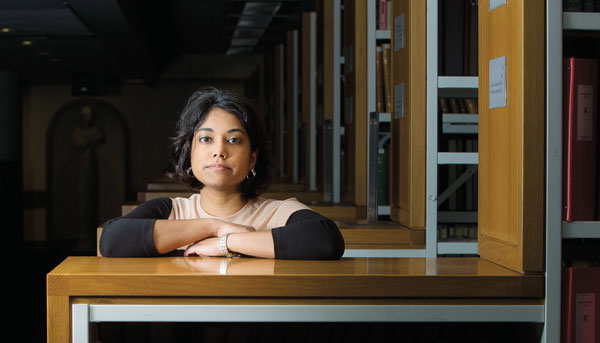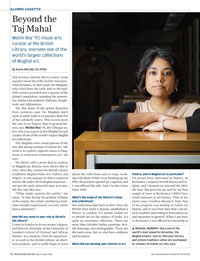Alumni Gazette
 MUGHAL MOMENT: Once one of the world’s most powerful dynasties, the Mughal empire—and its 300-year literary and artistic tradition—often are overlooked by scholars of Indian art, Roy says. (Photo: Joel Ryan/AP Images for Rochester Review)
MUGHAL MOMENT: Once one of the world’s most powerful dynasties, the Mughal empire—and its 300-year literary and artistic tradition—often are overlooked by scholars of Indian art, Roy says. (Photo: Joel Ryan/AP Images for Rochester Review)The Mughal Empire would easily make anyone’s short list of the world’s most powerful dynasties. At their peak, the Mughals, who ruled from the early 16th to the mid-19th century, presided over a quarter of the planet’s population, spanning the present-day Indian subcontinent, Pakistan, Bangladesh, and Afghanistan.
Yet, like many of the grand dynasties from centuries past, the Mughals don’t quite as easily make it on anyone’s short list of hot scholarly topics. This is even more the case in art history than in general history, says Malini Roy ’97, the Chicago native who is an expert in late Mughal art and curator of one of the world’s largest Mughal art collections.
The Mughals were noted patrons of the arts. But among scholars of Indian art, “the trend is to explore regional courts or kingdoms, or to focus on contemporary art,” she says.
Yet there’s still a great deal to explore in Mughal art. Britons were shown that in 2012, when Roy curated the British Library exhibition Mughal India: Art, Culture, and Empire. It was unusual in that it explored artistic life under all 15 Mughal emperors—not just the early, powerful ones, as is usually the case, Roy says.
“What might surprise the public,” she notes, “is that during the gradual collapse of the empire, the artistic and literary traditions actually experienced a revival, rather than a downturn.”
How did you come to your role at the British Library?
I came to London to do my master’s degree, and then my doctorate, at the University of London’s School of Oriental and African Studies. As a student, I had the opportunity to work at the British Library on short-term projects, and to really begin to learn about the collections and to enjoy working with them. While I was finishing up my PhD, the position opened up. I applied, and I was offered the role. And I’ve been here since 2008.
What’s the scope of the library’s visual arts collections?
Our collections date back to 1801, when the British East India Company established a library in London. It’s mostly Indian art or British art on the subject of India. It’s quite an enormous collection. There are more than 300,000 Indian paintings, British drawings, and photographs. Those are the main areas. But we also have sculpture and furniture.
When did you develop your interest in art history, and in Mughal art in particular?
I’d always been interested in history. At Rochester, I majored in both history and religion, and I focused on Asia and the Middle East. But growing up, and for my first couple of years at Rochester, I didn’t have much exposure to art history. Then in my junior year, I studied abroad in Italy. Part of my program was looking at Italian art history, and it was from then that I decided it would be interesting to learn about art and museums in general. When I got back to Rochester, I was offered an internship at the Strong Museum. I just started looking at different pockets of art. Then, during a trip to India, I spent some time at the Indian Museum in Kolkata and the National Museum in New Delhi, and those were my first real experiences looking at Indian art. It was quite colorful, and radically different from European art. And it was much less explored, which is why an art historian at the Strong Museum suggested to me that Indian art might be more rewarding to study than Western art. And from then I just started looking much more into the subject.
Your main interest is in the late Mughal period. Why?
When I started studying Mughal art, I was really looking at the 18th century onward. Early Mughal art has been exhaustively studied, and I really wanted to see what was happening when the empire was declining. British East India Company officers began to commission new works of art. Ultimately, this initiated a new style of art, or “Company” painting. This transitional period is what really piqued my interest.
What was your goal, from the outset, for the 2012–13 exhibition Mughal India: Art, Culture, and Empire?
When most people think about the Indian subcontinent, they think about the Taj Mahal, and many don’t realize it was commissioned by the Mughals. But we wanted to show people there was a Mughal culture beyond the Taj Mahal. We actually only included one picture of the Taj Mahal in the entire exhibition. And it was tucked away in a corner. That said, one of the things we found at the very end when we did our evaluation is that a lot of people were quite knowledgeable about the subject. And then there was a smaller percentage of people who were unfamiliar with the topic.
What did you learn as you were putting the exhibition together?
It was a pretty sharp learning curve. The exhibition was an opportunity to really explore the collection in detail. Because we have thousands of pieces in the collection, we went box by box, looking through pieces, and selecting things that were visually interesting, but then researching each item to see what historical connections could be drawn between them. It was amazing to discover unpublished material, including a manuscript of pigeon keeping and breeding. Of course, in the lead up to an exhibition, there’s never enough time to research all the manuscripts and paintings in great detail.
How did the exhibition help you set an agenda going forward?
Reviewing more than 300 years of painting, I was curious to explore why the tradition of Mughal art went into decline during the rule of the “puritanical” emperor, Aurangzeb, the last “Great” Mughal ruler. That’s something that hasn’t really been explored before. But there were other things we were looking at, such as natural history drawings. Both Mughal and European patrons were interested in learning about science and the natural world. There’s quite a treasure trove of natural history drawings at the library from the 18th and 19th centuries. So it gave me a chance to pull together smaller displays of this type of material.
In 2010, Britain and India agreed formally to build stronger artistic ties. Was this exhibition part of that effort?
The library itself has a memorandum of understanding with the Indian Ministry of Culture. And after the exhibition ended, we sent a facsimile version of the show, which was hosted at the Indira Gandhi Center for the Arts in New Delhi. It was really to share the British Library’s collections with the Indian public, and particularly artifacts related to the Mughal empire. It was inaugurated by the vice president of India. Unfortunately I had pneumonia, so I couldn’t go. But the head of our department was there to launch the show.

